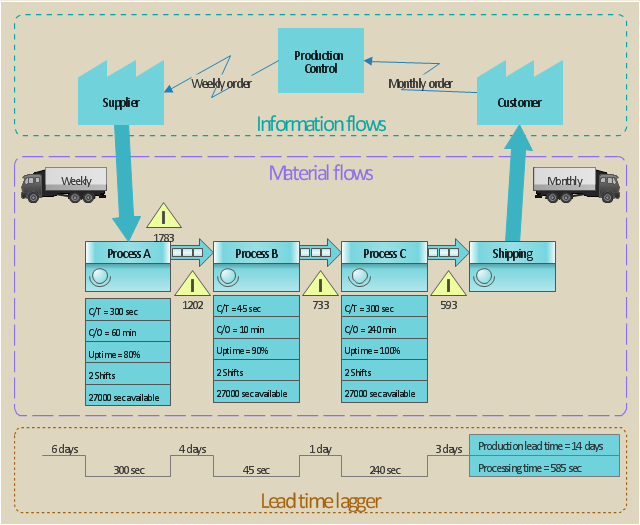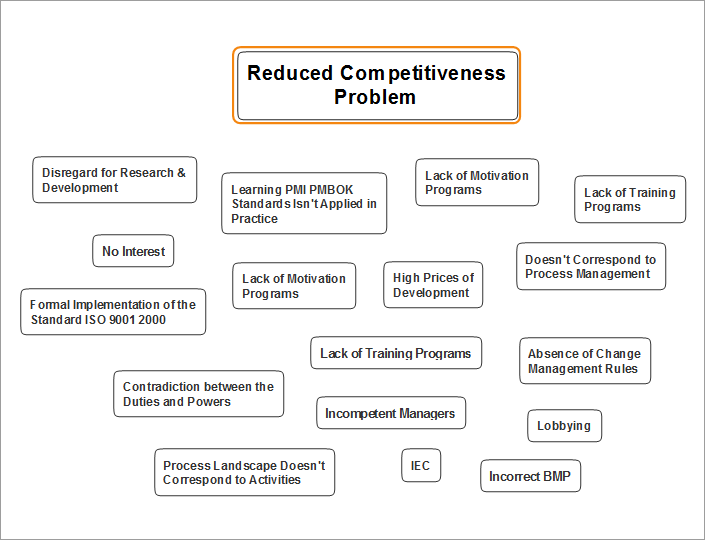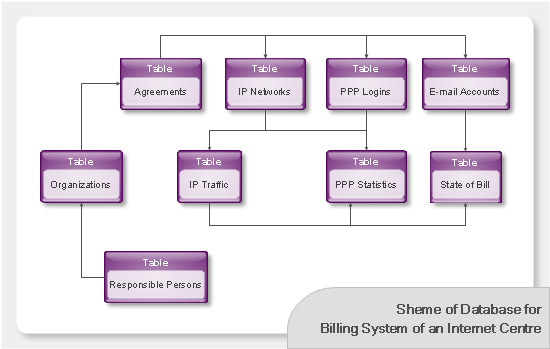This value stream map example was redesigned from the Wikipedia file: ValueStreamMapParts.png.
[en.wikipedia.org/ wiki/ File:ValueStreamMapParts.png]
This file is licensed under the Creative Commons Attribution-Share Alike 3.0 Unported license. [creativecommons.org/ licenses/ by-sa/ 3.0/ deed.en]
"Value stream mapping (VSM) refers to the activity of developing a visual representation of the flow of processes, from start to finish, involved in delivering a desired outcome, service, or product (a “value stream”) that is valued by customers. In the context of government, a value stream could be the process of conducting an audit, completing a procurement, or hiring new agency staff. VSM can increase understanding of actual decision-making processes and identify sources of non-value-added time (e.g., documents waiting to be reviewed). The typical products of a 2-5 day VSM workshop are a map of the “current state” of targeted processes and a “future state” map of the desired process flow and an associated implementation plan for future process improvement activities." [en.wikibooks.org/ wiki/ Business_ Analysis_ Guidebook/ LEAN]
The VSM diagram example "Value stream map parts" was created using the ConceptDraw PRO diagramming and vector drawing software extended with the Value Stream Mapping solution from the Quality area of ConceptDraw Solution Park.
[en.wikipedia.org/ wiki/ File:ValueStreamMapParts.png]
This file is licensed under the Creative Commons Attribution-Share Alike 3.0 Unported license. [creativecommons.org/ licenses/ by-sa/ 3.0/ deed.en]
"Value stream mapping (VSM) refers to the activity of developing a visual representation of the flow of processes, from start to finish, involved in delivering a desired outcome, service, or product (a “value stream”) that is valued by customers. In the context of government, a value stream could be the process of conducting an audit, completing a procurement, or hiring new agency staff. VSM can increase understanding of actual decision-making processes and identify sources of non-value-added time (e.g., documents waiting to be reviewed). The typical products of a 2-5 day VSM workshop are a map of the “current state” of targeted processes and a “future state” map of the desired process flow and an associated implementation plan for future process improvement activities." [en.wikibooks.org/ wiki/ Business_ Analysis_ Guidebook/ LEAN]
The VSM diagram example "Value stream map parts" was created using the ConceptDraw PRO diagramming and vector drawing software extended with the Value Stream Mapping solution from the Quality area of ConceptDraw Solution Park.
IDEF1 standard
Use Case Diagrams technology. Using visual graphical objects IDEF1 standard allows to model information interrelations.Brainstorming in ConceptDraw MINDMAP
Video tutorials on ConceptDraw products. Try it today!Databases Access Objects Model with ConceptDraw PRO
ConceptDraw Basic gives the opportunity of interaction with any ODBC-compatible databases. For this the Database Access Objects Model is provided. All calls to the database are made by certain methods of objects of this model.- Learn how to create a current state value stream map | Map of USA ...
- Learn how to create a current state value stream map | Value Stream ...
- Learn how to create a current state value stream map | Best Value ...
- Value Stream Mapping Template | Learn how to create a current ...
- value stream mapping , vsm , value stream , value stream map
- Business Process Mapping How to Map a Work Process | How to ...
- Value Stream Mapping
- Value stream map example | Marketing | Management |
- Cross Functional Flowchart Examples | Value-Stream Mapping for ...
- Business diagrams & Org Charts with ConceptDraw PRO | Business ...
- What is Value Stream Mapping ? | Value Stream Analysis | Value ...
- Best Value Stream Mapping mac Software - Conceptdraw.com
- How To create Value Stream Map (VSM) | VSM Template | Create a ...
- Value Stream Mapping - Design Elements ... - Conceptdraw.com
- Value Stream Mapping - Conceptdraw.com
- Value Stream Mapping | Quality Engineering Diagrams | Lean Value ...
- How To create Value Stream Map (VSM)
- What is Value Stream Mapping ?
- Lean Manufacturing Diagrams | Lean Value Stream Map | Lean ...
- Value Stream Mapping | Value Stream Diagram | Best Value Stream ...



